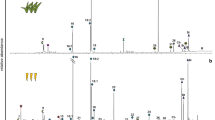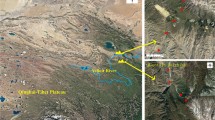Abstract
The bio-geographical significance of Rhododendron ponticum spp. baeticum (Ericaceae) as a relict species is well recognized. However, out of its native habitat it is an invasive exotic considered a major threat to natural ecosystems in areas of Atlantic Western Europe. The studies on the impact of Rhododendron influence on soil organic matter composition and associated ecological implications, i.e. presence of bioactive compounds with ecological significance, are limited. This work describes the soil lipid assemblage in three sites under Rhododendron stands and adjacent sites with deciduous oak (Quercus canariensis), both in their native habitats in Southern Spain (Sierra de Luna, Cádiz). The results are discussed in terms of organic matter dynamics and the presence of molecules that may be associated with Rhododendron invasive success. The soils are acid Xerochrepts formed on siliceous sands. Composite soil samples were taken at two depths (0–10 cm and 10–20 cm) and soxhlet extracted with a dichloromethane-methanol mixture (3:1). Soil lipid assemblage was studied by GC/MS after fractionation and appropriate derivatization of extracts. The qualitative chemical composition of soil extractable lipids under Rhododendron is reported here for the first time. Our results show that soil n-alkane and fatty acid distributions are compatible with an input from plant epicuticular waxes, as well as with the occurrence of selective preservation of long-chain fatty acids with depth. The pattern of short-chain n-alkanes found in surface samples indicates an anthropogenic contamination threat from nearby industrialized areas of “Campo de Gibraltar”. The presence of branched iso and anteiso C15 and C17, β-hydroxy fatty acids and the sterol brassicasterol points to high microbial soil activity. Finally, the pentacyclic triterpenes taraxerone and taraxerol were detected in soils with Rhododendron but not with Quercus. These are known bio-active plant compounds and could be related with the effectiveness of Rhododendron as an invasive exotic species.





Similar content being viewed by others
References
Ageta H, Ageta T (1984) Ericaceous constituents: seventeen triterpenoids isolated from the buds of Rhododendron macrocepalum. Chem Pharm Bull 32:369–372
Aguilar-Guadarrama B, Navarro V, Leon-Rivera I, Rios MY (2009) Active compounds against tinea pedis dermatophytes from Ageratina pichinchensis var. bustamenta. Nat Prod Res 23:1559–1565
Almendros G, Sanz J, Velasco F (1996) Signatures of lipid assemblages in soils under continental Mediterranean forest. Eur J Soil Sci 47:183–196
Amblès A, Magnoux P, Jambu P, Jacquesy R, Fustec E (1989) Effects of addition of bentonite on the hydrocarbon fraction of a podzol soil (A1) horizon. J Soil Sci 40:685–694
Arias ME, González-Pérez JA, González-Vila FJ, Ball AS (2005) Soil health—a new challenge for microbiologists and chemists. Int Microbiol 8:13–21
Balsdon JA, Espelie KE, Braman SK (1995) Epicuticular lipids from Azalea (Rhododendron spp) and their potential role in host-plant acceptance by Azalea Lace Bug, Stephanitis pyrioides (Heteroptera, Tingidae). Biochem Syst Ecol 23:477
Bull ID, van Bergen PF, Nott CH, Poulton PR, Evershed RP (2000) Organic geochemical studies of soils from the Rothamsthed classical experiments. V. The fate of lipids in different long-term experiments. Org Geochem 31:389–408
Canuel EA, Freeman KH, Wakeham SG (1997) Isotopic composition of lipid biomarker compounds in estuarine plants and surface sediments. Limnol Oceanogr 42:1570–1583
CEBAC (1963) Estudio agrobiológico de la provincia de Cádiz. Servicio de Publicaciones de la Diputación Provincial de Sevilla, Spain, p 357
Chandler RF, Hooper SN (1979) Friedelin and associated triterpenoids. Phytochemistry 18:711–724
Cross JR (1981) The establishment of Rhododendron ponticum in the Killarney oak woods, SW Ireland. J Ecol 69:807–824
Erfmeier A, Bruelheide H (2004) Comparison of native and invasive Rhododendron ponticum populations: Growth, reproduction and morphology under field conditions. Flora 199:120–133
Evans D, Knights BA, Math VB (1975) Steryl acetates in Rhododendron waxes. Phytochemistry 14:2453–2454
Farrimond P, Flanagan RL (1996) Lipid stratigraphy of a Flandrian peat bed (Northumberland, UK)–Comparison with the pollen record. The Holocene 6:69–74
González-Gallero FJ, Galán-Vallejo M, Umbría A, Gervilla-Baena J (2006) Multivariate statistical analysis of meteorological and air pollution data in the ‘Campo de Gibraltar’ region, Spain. Environ Monit Assess 119:405–423
Hashimoto N, Adyama T, Shioiri T (1981) New methods and reagents in organic synthesis. A simple efficient preparation of methyl esters with trimethylsilydiazomethane (TMSCHN2) and its application to gas chromatographic analysis of fatty acids. Chem Pharm Bull 29:1475–1478
Hatcher PG, Spiker EC (1988) Selective degradation of plant biomolecules. In: Frimmel FH, Christman RF (eds) Humic substances and their role in the environment. Wiley, Chichester, pp 59–75
Hempfling R, Schulten H-R (1989) Selective preservation of biomolecules during humification of forest litter studied by pyrolysis-field ionization mass spectrometry. Sci Total Environ 81(82):31–40
Hernández AJ, Pastor J (1989) Técnicas analíticas para el estudio de las interacciones suelo-planta. Henares Rev Geol 3:67–102
Hernández ME, Mead R, Peralba MC, Jaffé R (2001) Origin and transport of n-Alkane-2-ones in a subtropical estuary: potential biomarkers of a seagrass-derived organic matter. Org Geochem 32:21–32
Jaffé R, Wolff GA, Cabrera AC, Carvajal-Chitty H (1995) The biogeochemistry of lipids in rivers of the Orinoco Basin. Geochim Cosmochim Acta 59:4507–4522
Jambu P, Amblès A, Dinel H, Secouet B (1991) Incorporation of natural hydrocarbons from plant residues into a hydromorphic humic podzol following afforestation and fertilization. J Soil Sci 42:629–636
Jandl G, Leinweber P, Schulten HR (2007) Origin and fate of soil lipids in a Phaeozem under rye and maize monoculture in Central Germany. Biol Fertil Soils 43:321–332
Jansen B, Nierop KGJ, Tonneijck FH, van der Wielen FWM, Verstraten JM (2007) Can isoprenoids in leaves and roots of plants serve as biomarkers for past vegetation changes? A case study from the Ecuadorian Andes. Plant Soil 291:181–198
Li M, Larter SR, Taylor P, Jones DM, Bowler B, Bjoroy M (1995) Biomarkers or not biomarkers? A new hypothesis for the origin of pristane involving derivation from methyltrimethyltridecychromans (MTTCs) formed during diagenesis from chlorophylland alkylphenols. Org Geochem 23:159–167
Lichtfouse E, Berthier G, Houot S, Barriuso E, Bergheaud V, Vallaeys T (1995) Stable carbon isotope evidence for the microbial origin of C14–C18 n-alkanoic acids in soils. Org Geochem 23:849–852
Lichtfouse E, Bardoux G, Mariotti A, Balesdent J, Ballentine DC, Macko SA (1997) Molecular, 13C, and 14C evidence for the allochthonous and ancient origin of C16–C18 n-alkanes in modern soils. Geochim Cosmochim Ac 61:1891–1898
Macías-Rubalcava ML, Hernández-Bautista BE, Jiménez-Estrada M, Cruz-Ortega R, Anaya AL (2007) Pentacyclic triterpenes with selective bioactivity from Sebastiania adenophora leaves, Euphorbiaceae. J Chem Ecol 33:147–156
Mejías JA, Arroyo J, Marañón T (2007) Ecology and biogeography of plant communities associated with the post Plio-Pleistocene relict Rhododendron ponticum sbsp. baeticum in southern Spain. J Biogeogr 34:456–472
Milne RI, Abbott RJ (2000) Origin and evolution of invasive naturalized material of Rhododendron ponticum L. in the British Isles. Mol Ecol 9:541–556
Mitchell RJ, Marrs RH, Auld MHD (1998) A comparative study of the seedbanks of heathlands and successional habitats in Dorset, Southern England. J Ecol 86:588–596
Naafs DFW, Van Bergen PF, De Jong MA, Oonincx A, De Leeuw JW (2004) Total lipid extracts from characteristic soil horizons in a podzol profile. Eur J Soil Sci 55:657–669
Nakamura S, Yamada T, Wada H, Inoue T, Goto T, Hirata Y (1965) The structure of five new triterpenoids obtained from Rhododendron linearifolium. Tetrahedron Lett 6:2017–2022
Nierop KGJ, van Lagen B, Buurman P (2001) Composition of plant tissues ands oil organic matter in the first stages of a vegetation succession. Geoderma 100:1–24
Quenea K, Derenne S, Largeau C, Rumpel C, Mariotti A (2004) Variation in lipid relative abundance and composition among different particle size fractions of a forest soil. Org Geochem 35:1355–1370
Rontani JF, Volkman JK (2003) Phytol degradation products as biogeochemical tracers in aquatic environments. Org Geochem 34:1–35
Salasoo I (1987) Alkane distribution in epicuticular wax of some heath plants in Norway. Biochem Syst Ecol 15:663–665
Schwark L, Zink K, Lechterbeck J (2002) Reconstruction of postglacial to early Holocene vegetation history in terrestrial Central Europe via cuticular lipid biomarkers and pollen records from lake sediments. Geology 30:463–466
Tasdemir D, Dönmez A, Çalıs I, Rüedi P (2004) Evaluation of biological activity of Turkish plants. Rapid screening for the antimicrobial, antioxidant, and acetylcholinesterase inhibitory potential by TLC bioautographic methods. Pharm Biol 42:374–383
Ten Haven HL, Baas M, De Leeuw JW, Schenck PA, Brinkhuis H (1987) Late Quaternary Mediterranean sapropels II. Organic geochemistry and palinology of S1 sapropels and associated sediments. Chem Geol 64:149–167
Travis J (2003) How does invasion of Rhododendron ponticum impact on soil biodiversity and ecosystem function? Bull British Ecol Soc 34:35
Van Smeerdijk DG, Boon JJ (1987) Characterisation of subfossil Sphagnum leaves, rootlets of Ericaceae and their peat by pyrolysis high resolution gas chromatography mass spectrometry. J Anal Appl Pyrolysis 11:377–402
Volkman JK (1986) A review of sterol markers for marine and terrigenous organic matter. Org Geochem 9:83–99
Williams LAD (1999) Rhizophora mangle (Rhizophoraceae) triterpenoids with insecticidal activity. Naturwissenschaften 86:450–452
Acknowledgments
The authors wish to thank Trinidad Verdejo for assisting in the GC/MS spectrometry. Thoughtful comments and the meticulous care of Eric Lichtfouse in handling this manuscript are sincerely acknowledged. They also wish thank two anonymous reviewers for their helpful comments.
Author information
Authors and Affiliations
Corresponding author
Rights and permissions
About this article
Cite this article
González-Pérez, J.A., González-Vila, F.J., Arias, M.E. et al. Geochemical and ecological significance of soil lipids under Rhododendron ponticum stands. Environ Chem Lett 9, 453–464 (2011). https://doi.org/10.1007/s10311-010-0300-4
Received:
Accepted:
Published:
Issue Date:
DOI: https://doi.org/10.1007/s10311-010-0300-4




